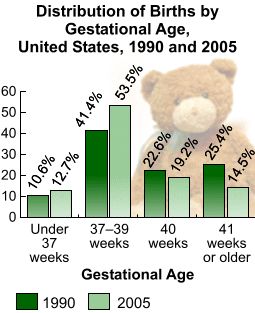Data & Statistics
Other Features
Featured Data & Statistics

Births by Gestational Age
Distribution of Births by Gestational Age, United States, 1990 and 2005
The distribution of births by gestational age changed between 1990 and 2005. The percentage of preterm births (<37 completed weeks of gestation) increased 20%, from 10.6% to 12.7%; the percentage of births at 37--39 weeks of gestation also increased, from 41.4% to 53.5%, a 29% increase. In contrast, the percentage of infants born at 40 weeks and especially 41 weeks of gestation declined (15% and 43%, respectively).
Data Source: National Vital Statistics System. Births: preliminary data for 2005. Available at:
http://www.cdc.gov/nchs/products/pubs/pubd/
hestats/prelimbirths05/prelimbirths05.htm.
Citation:
Centers for Disease Control and Prevention. QuickStats: Distribution of Births, by Gestational Age –United States. MMWR 2007;56:14(344). Available from: http://www.cdc.gov/mmwr/preview/mmwrhtml/mm5614a7.htm.
Additional Information and Resources
March of Dimes Resources
Prematurity Campaign*
More information about premature birth and the March of Dimes prematurity campaign.
Share Your Story* (Spanish language online community also available)
Virtual community for parents with a baby in a neonatal intensive care unit.
PeriStats*
This Web site provides a wealth of national, state, and local perinatal statistics.
Preterm Labor and Birth
More information from the National Institute of Child Health and Human Development.
Premature Babies
The National Library of Medicine provides links to the latest news and research on preterm birth.
National Prematurity Awareness Month
More than a half million babies in the United States—that's 1 in every 8—are born premature each year.
Healthy Pregnancy
Learn how to be healthy (before, during, and after pregnancy) and give your baby a healthy start to life.
Podcast About Premature Births (For Healthcare Providers), 10/6/2006
Listen To This Podcast... (6:33)
Podcast About Premature Births (For Consumers), 10/6/2006
Listen To This Podcast... (5:19)
CDC’s Division of Reproductive Health
Promotes optimal reproductive and infant health. CDC scientists and their partners are collaborating with states, university researchers and partners in health care to understand why preterm births occur, and what can done to prevent prematurity.
CDC’s National Center on Birth Defects and Developmental Disabilities
Promotes the health of babies, children, and adults, and enhances the potential for full, productive living.
*Links to non-federal organizations are provided solely as a service to our users. These links do not constitute an endorsement of these organizations or their programs by CDC or the federal government, and none should be inferred. CDC is not responsible for the content of the individual organization Web pages found at these links.
Page last reviewed: November 21, 2007
Page last updated: November 21, 2007
Content source:MMWR and Division of Reproductive Health, National Center for Chronic Disease Prevention and Health Promotion
Content owner: National Center for Health Marketing
URL for this page: http://www.cdc.gov/datastatistics/2007/births/
